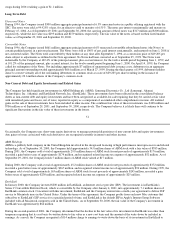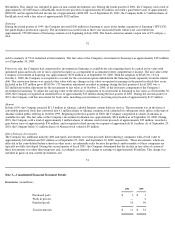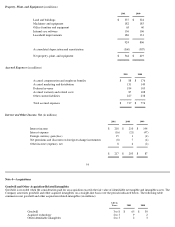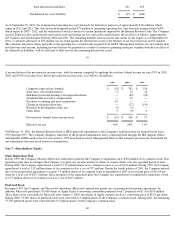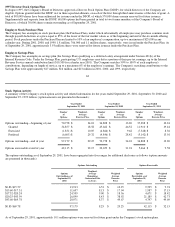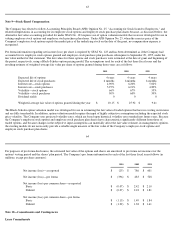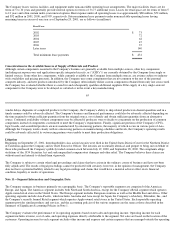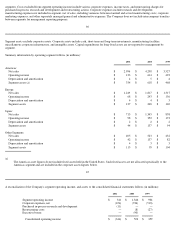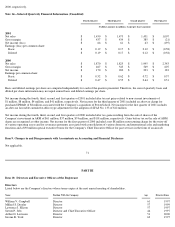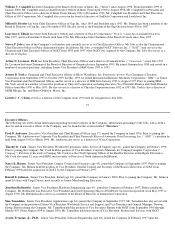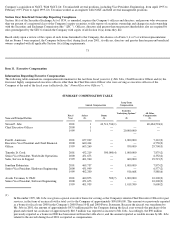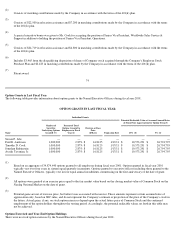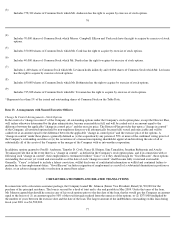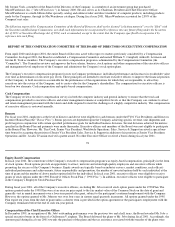Apple 2001 Annual Report Download - page 50
Download and view the complete annual report
Please find page 50 of the 2001 Apple annual report below. You can navigate through the pages in the report by either clicking on the pages listed below, or by using the keyword search tool below to find specific information within the annual report.
The Company leases various facilities, and equipment under noncancelable operating lease arrangements. The major facilities leases are for
terms of 5 to 10 years and generally provide renewal options for terms of 3 to 5 additional years. Leases for retail space are for terms of from 5
to 12 years and often contain multi-year renewal options. Rent expense under all operating leases was approximately $80 million, $72 million,
and $52 million in 2001, 2000, and 1999, respectively. Future minimum lease payments under noncancelable operating leases having
remaining terms in excess of one year as of September 29, 2001, are as follows (in millions):
Concentrations in the Available Sources of Supply of Materials and Product
Although certain components essential to the Company's business are generally available from multiple sources, other key components
(including microprocessors and application-specific integrated circuits, or ("ASICs")) are currently obtained by the Company from single or
limited sources. Some other key components, while currently available to the Company from multiple sources, are at times subject to industry
wide availability and pricing pressures. In addition, the Company uses some components that are not common to the rest of the personal
computer industry, and new products introduced by the Company often initially utilize custom components obtained from only one source until
the Company has evaluated whether there is a need for and subsequently qualifies additional suppliers.If the supply of a key single-sourced
component to the Company were to be delayed or curtailed or in the event a key manufacturing
65
vendor delays shipments of completed products to the Company, the Company's ability to ship related products in desired quantities and in a
timely manner could be adversely affected. The Company's business and financial performance could also be adversely affected depending on
the time required to obtain sufficient quantities from the original source, or to identify and obtain sufficient quantities from an alternative
source. Continued availability of these components may be affected if producers were to decide to concentrate on the production of common
components instead of components customized to meet the Company's requirements. Finally, significant portions of the Company's CPUs,
logic boards, and assembled products are now manufactured by outsourcing partners, the majority of which occurs in various parts of Asia.
Although the Company works closely with its outsourcing partners on manufacturing schedules and levels, the Company's operating results
could be adversely affected if its outsourcing partners were unable to meet their production obligations.
Litigation
Beginning on September 27, 2001, threeshareholder class action lawsuits were filed in the United States District Court for the Northern District
of California against the Company and its Chief Executive Officer. The lawsuits are essentially identical, and purport to bring suit on behalf of
those who purchased the Company's publicly traded common stock between July 19, 2000, and September 28, 2000. The complaints allege
violations of the 1934 Securities Act and seek unspecified compensatory damages and other relief. The Company believes these claims are
without merit and intends to defend them vigorously.
The Company is subject to certain other legal proceedings and claims that have arisen in the ordinary course of business and have not been
fully adjudicated. The results of legal proceedings cannot be predicted with certainty; however, in the opinion of management, the Company
does not have a potential liability related to any legal proceedings and claims that would have a material adverse effect on its financial
condition, liquidity or results of operations.
Note 11—Segment Information and Geographic Data
The Company manages its business primarily on a geographic basis. The Company's reportable segments are comprised of the Americas,
Europe, and Japan. The Americas segment includes both North and South America, except for the Company's Retail segment which operates
Apple-owned retail stores in the United States. The Europe segment includes European countries as well as the Middle East and Africa. Other
operating segments include Asia-Pacific, which includes Australia and Asia except for Japan, the Company's subsidiary, Filemaker, Inc., and
the Company's recently formed Retail segment which operates Apple-owned retail stores in the United States. Each reportable operating
segment provides similar products and services, and the accounting policies of the various segments are the same as those described in the
Summary of Significant Accounting Policies in Note 1.
The Company evaluates the performance of its operating segments based on net sales and operating income. Operating income for each
segment includes revenue, cost of sales, and operating expenses directly attributable to the segment. Net sales are based on the location of the
customers. Operating income for each segment excludes other income and expense and certain expenses that are managed outside the operating
Fiscal Years
2002
$
73
2003
72
2004
62
2005
47
2006
37
Later years
140
Total minimum lease payments
$
431


